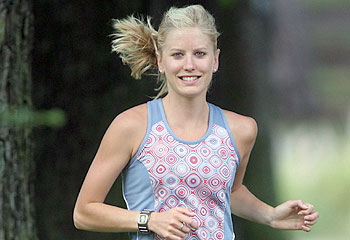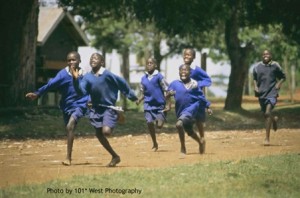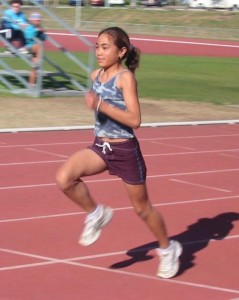There are many very young (9-13yrs old) extremely talented athletes out there. Some of them like Australia’s Georgie Clarke can make great progress at an early age. 800m age 11 2:12 age 12 2:08 age 13 2:05 age 14 2:02 ….age 16 2000 Olympics Semi-Final in the 1500m . In the early years, she was on a very minimal and varied program and still performed brilliantly.
You only have to watch any young Athletics Championships. Some of them are showing talent because they are simply early maturers or they have already done plenty of specific training. BUT there are some that are showing the necessary qualities required to really do something great on the track as mature senior athletes and have done very little specific training. The question is what do we do with this latter group of super talented athletes? The answer to this question is often full of distractions most of them seeded in jealousy and rivalry. eg. Accusations of athletes being trained too hard are common. Even when the athlete is doing a good variety in training.
We have to recognize that many other sports start their preparation much younger than Athletics. If we want athletes with good qualities as adults our young athletes need good long-term preparation. Sitting down all day watching TV or at school, wearing shoes all day, only exercising in competition and not having a variety of experiences of the positive effects of exercise are just some of the obstacles we face. In African Nations, the children do a lot of variety of activities as part of their lifestyle that gives them strength and conditioning. If we want our athletes in any sport to have a chance we have to provide them with variety when they are young or we will have to play catch up later to keep our athletes healthy.
These super potential young athletes need a broad base of training stimuli. They need coaches that are willing to arrange it for them. Not Coaches that will focus ONLY on the areas that give good results fast. Adrian Faccioni and Di Barnes presented some great information at the 2001 Australian Track & Field Coaches Congress. http://www.faccioni.com/lectures/juniorcondition.PDF Athletes at this stage of development should have great variety in their programs. What follows are some examples and ideas:
Swiss Ball – training sessions – great for mid-torso development and balance.eg 20min session maybe 1-2 a week, follow videos or do a class.
Pilates – do a floor class or follow a video – similar to above. Maybe even integrate some of these exercises into a warmup phase of a session. -maybe 1 a week
Gym – Train with free weights only and avoid max weight lifts. It is important for young athletes to develop strength. However, good guidance and supervision is needed. Variety in the program is needed. Start with small duration sessions – maybe just 1 a week.
Steady Running – run on grass, dirt and mixed uneven terrain at varying speeds, make it fun. Kenyan athletes who are in their thirties in many cases are athletes that were playing on their farms (strength training) and play running 100+ km a week to get to school on uneven terrain from age 6. The trick is NOT to structure it and have young athletes pound out the steady continuous runs at an even pace on even terrain (road) or on a track!!. If we got Kenyan youngsters to do this they would not last long either. There is no reason why our young athletes cannot do regular play like runs of 30min on un-even surfaces combined with walking or long all day bushwalks etc. Make it as natural as possible – search out trails and stay off paths and roads.
Bushwalks – are a great way to build base stamina and strengthen legs. A very natural exercise mode. There are some great ones in any National Park.
Other Sports – Participation in a variety of other sports is good for all-round development both physically and psychologically. We just need to make sure that in whatever other sport they play that the training and competition should be very varied and appropriate. Many other sports are years behind athletics in using methods that are the best in training for running.
Athletes that prepare for Athletics following the general philosophy presented here will be prepared brilliantly for other sports that they may play or later specialize in.
Medicine Ball – med ball exercises can be performed that are good for everything from balance, strength, power etc. Maybe even help our athletes not get knocked over as easily.
Be creative.
Foot/ankle/lower leg conditioning – walking on toes, walking on heels, walk on soft sand, foot strengthening eg roll up a towel, pickup pencils etc.
Plyometrics – bouncing exercises of varied intensity in different directions. Maybe over obstacles or up onto obstacles. Do standing Long Jump tests. Play hopscotch. Ease into it gently and design other fun games to play. Whatever athletes are regularly doing will generally not be a problem.
Competition – DO NOT over compete. Young athletes should enjoy the process of all aspects of this sport. It is common to see underprepared athletes (that are supposedly being looked after) over competing by going in multiple races a few times a week. Athletes cannot work on technique when under pressure. Competing a lot may be fun but is the quickest way to create future problems. When athletes do compete in a variety of settings against athletes of varied ages and levels, and in different events. Spending all day at track meets or Gala days is not everyone’s idea of fun so try to spend quality time at the track. Not hours waiting for the next event.
Speed improvement – this is an important age for the development of speed. To not work on it now may mean missing the boat. Increasing cadence and improving coordination is very important.
Technical improvement- This is paramount to longevity. Young athletes must spend enough time each week improving their technique. The common way to compromize this development is to compete too much (no athlete will be able to change an old technique during max effort situations) or do too much of one type of training eg focusing only on aerobic development.
There are many talented athletes that fail to make it or develop chronic injuries that prevent them from reaching their full potential. I believe that with these athletes we can maximize their chances of avoiding problems by providing them with a varied program and ALWAYS focusing on improving technically and being patient. Never let one type of training dominate the others. When the athletes are mature then it may be more appropriate to let certain kinds of training dominate the program ESPECIALLY if as a young athlete they were exposed to a few years of multilateral training and now have excellent posture/technique etc. In the meantime athletes that train with variety will likely meet success off relatively small volumes of training in every area and show good performance improvements anyway. The best way to judge a program is that the athlete should improve steadily technically. There may be hiccups as the athlete has a growth spurt for example BUT generally, the athlete should be improving technically throughout their foundation years.
“Saving kids for later” by getting them to do next to nothing in a low key program is a myth that will never produce talented athletes that are resilient as adults.


